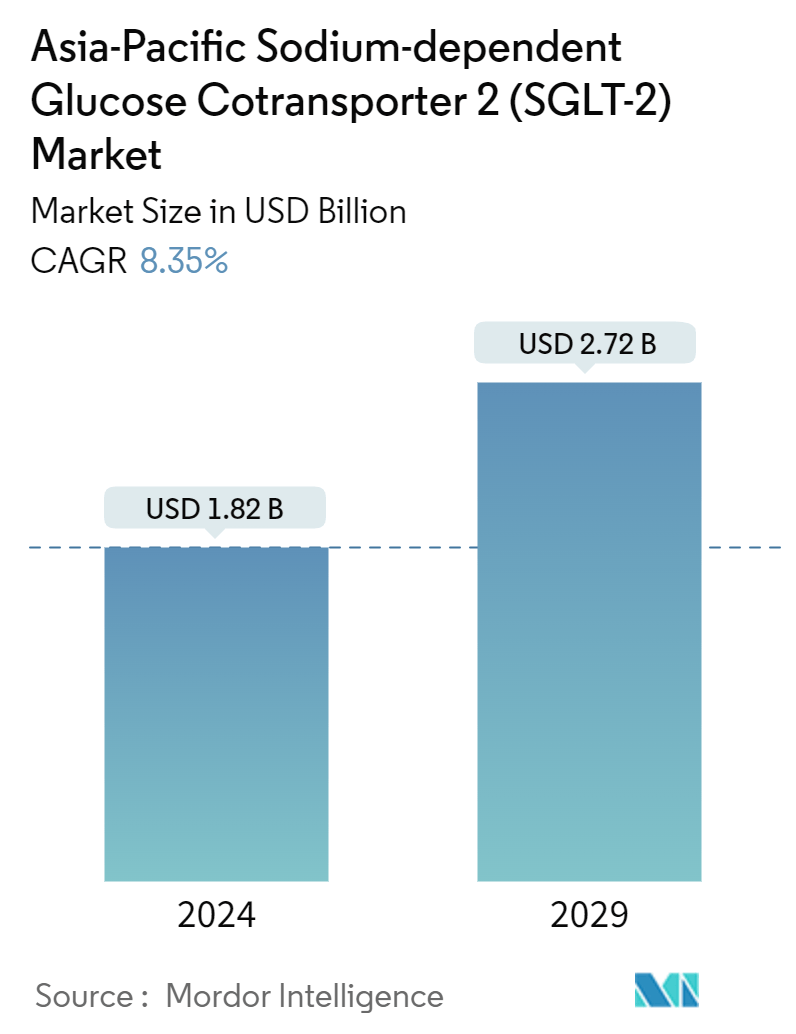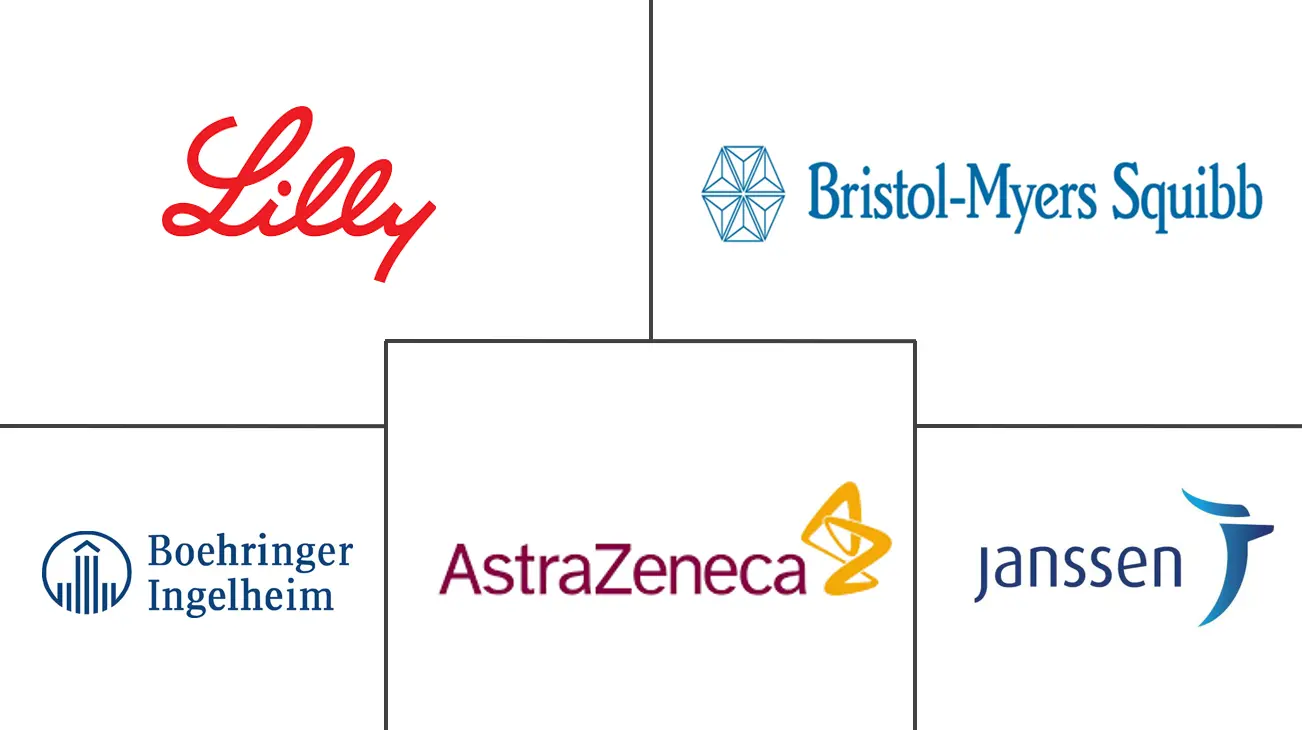Market Size of Asia-Pacific Sodium-dependent Glucose Cotransporter 2 (SGLT-2) Industry

| Study Period | 2018 - 2029 |
| Base Year For Estimation | 2023 |
| Market Size (2024) | USD 1.82 Billion |
| Market Size (2029) | USD 2.72 Billion |
| CAGR (2024 - 2029) | 8.35 % |
| Market Concentration | Low |
Major Players
*Disclaimer: Major Players sorted in no particular order |
Asia-Pacific Sodium-dependent Glucose Cotransporter 2 (SGLT-2) Market Analysis
The Asia-Pacific Sodium-dependent Glucose Cotransporter 2 Market size is estimated at USD 1.82 billion in 2024, and is expected to reach USD 2.72 billion by 2029, growing at a CAGR of 8.35% during the forecast period (2024-2029).
SGLT-2 inhibitors also called gliflozins are a class of medicine used to lower high blood glucose levels in people with type 2 diabetes. SGLT-2 drugs have a significant role in managing cardiovascular risk factors including blood pressure, glycemia, weight, cardiac function, and antiinflammatory activity. Diabetic drugs have been potential candidates for treating diabetic patients affected by SARS-CoV-2 infection during the COVID-19 pandemic.
The Asia-pacific region had witnessed an alarming increase in the prevalence of diabetes, in recent years. Diabetes is associated with many health complications. Patients with diabetes require many corrections throughout the day for maintaining nominal blood glucose levels, such as medications or ingestion of additional carbohydrates by monitoring their blood glucose levels.
Diabetes mellitus has been of wide concern with its high prevalence, resulting in increased financial burdens for clinical systems, individuals, and governments. The market players are adopting various strategies such as collaborations, partnerships, mergers, acquisitions, and expansions to increase market share. Technological advancements have increased over the period leading to several modifications either in the SGLT-2 inhibitors or the formulations being developed.
According to International Diabetes Federation, 90 million adults were living with diabetes in the IDF South-East Asia Region. This figure is estimated to increase to 152 million by 2045, and 206 million adults were living with diabetes in the IDF Western Pacific Region, which is estimated to increase to 260 million by 2045. The Asia-Pacific region witnessed an alarming increase in the prevalence of diabetes in recent years. In developing countries, such as China and India, the rate of diabetes is at an all-time high. Also, the use of oral anti-diabetes drugs is rising because new-generation drugs reduce the rate of CV risk in diabetes patients. Leading manufacturers are focusing on technological innovations and developing advanced products to gain a substantial market share.
Therefore, due to increased prevalence and the aforementioned factors, the studied market is anticipated to witness growth over the analysis period.
Asia-Pacific Sodium-dependent Glucose Cotransporter 2 (SGLT-2) Industry Segmentation
SGLT-2 inhibitors are an oral medication for treating type 2 diabetes in adults. They are prescription drugs called sodium-glucose co-transporter-2 inhibitors (SLGT2i) or gliflozins. The Asia-Pacific Sodium-dependent Glucose Cotransporter 2 (SGLT-2) Market is segmented into drugs and geography. The report offers the value (in USD) and volume (in units) for the above segments.
| Geography | |
| Japan | |
| South Korea | |
| China | |
| India | |
| Australia | |
| Vietnam | |
| Malaysia | |
| Indonesia | |
| Philippines | |
| Thailand | |
| Rest of Asia-Pacific |
Asia-Pacific Sodium-dependent Glucose Cotransporter 2 (SGLT-2) Market Size Summary
The Asia-Pacific Sodium-dependent Glucose Cotransporter 2 (SGLT-2) inhibitors market is poised for significant growth, driven by the increasing prevalence of diabetes in the region. SGLT-2 inhibitors, also known as gliflozins, are crucial in managing type 2 diabetes by lowering blood glucose levels and addressing cardiovascular risk factors such as blood pressure and weight. The rising incidence of diabetes, particularly in countries like China and India, has heightened the demand for these medications. The market is characterized by strategic collaborations and technological advancements, with key players focusing on innovative product development to capture a larger market share. The region's market landscape is dominated by major manufacturers like Eli Lilly, Sanofi, and Novo Nordisk, who have strengthened their presence through joint ventures and partnerships.
Japan stands out as a significant market within the Asia-Pacific region, attributed to its large elderly population and the associated rise in type 2 diabetes cases. The country's healthcare system prioritizes diabetes management, offering comprehensive medical coverage and access to care, which mitigates the financial burden of the disease. The market's growth is further supported by the approval of new medications, such as Jardiance and Synjardy, for pediatric use, expanding the treatment options available. The SGLT-2 inhibitors market is expected to continue its upward trajectory, driven by the increasing adoption of oral anti-diabetes drugs and the ongoing efforts to enhance treatment efficacy and patient adherence.
Asia-Pacific Sodium-dependent Glucose Cotransporter 2 (SGLT-2) Market Size - Table of Contents
-
1. MARKET DYNAMICS
-
1.1 Market Overview
-
1.2 Market Drivers
-
1.3 Market Restraints
-
1.4 Porter's Five Forces Analysis
-
1.4.1 Bargaining Power of Suppliers
-
1.4.2 Bargaining Power of Consumers
-
1.4.3 Threat of New Entrants
-
1.4.4 Threat of Substitute Products and Services
-
1.4.5 Intensity of Competitive Rivalry
-
-
-
2. MARKET SEGMENTATION
-
2.1 Invokana (Canagliflozin)
-
2.2 Jardiance (Empagliflozin)
-
2.3 Farxiga/Forxiga (Dapagliflozin)
-
2.4 Suglat (Ipragliflozin)
-
2.5 Geography
-
2.5.1 Japan
-
2.5.2 South Korea
-
2.5.3 China
-
2.5.4 India
-
2.5.5 Australia
-
2.5.6 Vietnam
-
2.5.7 Malaysia
-
2.5.8 Indonesia
-
2.5.9 Philippines
-
2.5.10 Thailand
-
2.5.11 Rest of Asia-Pacific
-
-
Asia-Pacific Sodium-dependent Glucose Cotransporter 2 (SGLT-2) Market Size FAQs
How big is the Asia-Pacific Sodium-dependent Glucose Cotransporter 2 Market?
The Asia-Pacific Sodium-dependent Glucose Cotransporter 2 Market size is expected to reach USD 1.82 billion in 2024 and grow at a CAGR of 8.35% to reach USD 2.72 billion by 2029.
What is the current Asia-Pacific Sodium-dependent Glucose Cotransporter 2 Market size?
In 2024, the Asia-Pacific Sodium-dependent Glucose Cotransporter 2 Market size is expected to reach USD 1.82 billion.

